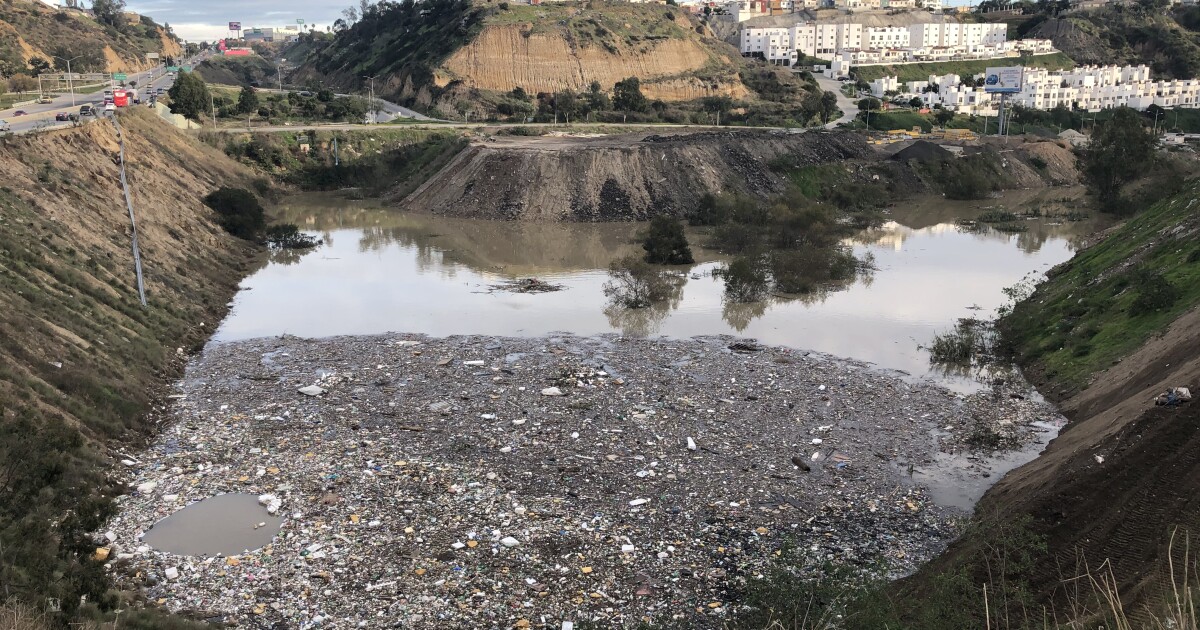
It started with last month’s heavy rains that brought an unprecedented volume of debris tumbling down Tijuana’s Matadero Canyon: old mattresses, used furniture, discarded construction material. That led to a clogged storm drain by the border fence, and the flooding of a nearby sewage pump station.
The resulting pool of trash and sewage-contaminated water has now been raising fears in San Diego.
“We’re concerned that when they unblock the storm drain, all that water is going to make its way into Smuggler’s Gulch,” said David Gibson, head of the San Diego Regional Water Quality Control Board.
While crews in Mexico work to clear the putrid clog, authorities in the U.S. have been bracing for a sudden surge of contaminated water and trash into the low-lands near Monument Road and Hollister Street.
Advertisement
On Thursday night, authorities barred traffic along Monument Road as a precautionary measure, said Anthony Santacroce, a city spokesman. Border Patrol, police, firefighters and lifeguards have been put on notice. The road was open to traffic Friday.
There is a long history of sewage-contaminated water crossing from Tijuana and periodically shutting down beaches in southern San Diego County.
But last month’s strong rains have served to also highlight the problems caused by solid waste dumped illegally in Tijuana’s canyons that washes downstream and risks ending up in the Tijuana Estuary, a federally protected wetland.
Baja California authorities have tallied 366 clandestine trash dumps in Tijuana. Mexico’s statistics agency, INEGI, has calculated that 15 percent of the trash produced in Tijuana is not collected. Despite periodic canyon cleanups in Tijuana and warnings against dumping, the practice continues.
Advertisement
“It’s difficult to control, they do it at night, at moments that we’re not monitoring, and this is the result,” said Francisco Moreno Escalante, an assistant director in the city’s Urban Development Secretariat.
The issue of cross-border contamination has been one of growing concern in recent years in southern San Diego County. It has been the subject of lawsuits against the U.S. federal government by cities of San Diego, Imperial Beach, Chula Vista, as well as the Port of San Diego and the San Diego Regional Water Quality Control Board.
The rising pool of trash and contaminated water at the foot of Matadero Canyon, estimated at more than 300,000 cubic meters, is putting the issue in plain view, as it sits just off the busy international highway that parallels the border’s western end — and just a third of a mile from the U.S. border fence.
As the rains have abated, city, state and federal authorities in Mexico joined forces this past week to remove the trash and re-open the storm drain. Engineers said they had never seen a problem on this magnitude in Matadero Canyon, one of the largest of some 400 canyons in Tijuana that drain into the Tijuana River Channel.
“Because the rain was so heavy, and there are more people living in the channels and stream beds, we’re seeing bigger problems,” said Jose Luis Rosas, the city’s civil protection director, as he surveyed the launching of cleanup efforts on Monday. Before the rains hit, workers evicted people found living in the canyon’s storm drain, he said.
The downpours also carried large amounts of solid waste that ended up on the beach at Playas de Tijuana. Anna Lucia Lopez Avedoy, a Tijuana environmental activist, said volunteers participating in a New Year’s Day beach cleanup found a number of large items, including a mattress, a motor case and several black bags filled with trash.
Last month, the city began sending out trucks to pick up heavy items such as stoves, furniture, mattresses, sofas — items that are not picked up during the regular collection service. But the city has a limited budget for such efforts, and unless residents refrain from dumping, the problem is likely to continue.
One measure that can start to reduce the solid waste disposal is a municipal recycling program, said Manuel Rodriguez Monarrez, director of planning and policy in Baja California’s Environmental Protection Secretariat. But existing contracts and the power of unions make change difficult. “It’s a matter of political will, one that will require sacrifices, focus and measures against corruption.”
Advertisement
The issue of cross-border flows come under new scrutiny this week, less than a month after a newly approved trade treaty with the United States, Mexico and Canada committed the U.S. federal government to provide $300 million on infrastructure projects to address pollution on the U.S.-Mexico border. The agreement did not stipulate where the funds would be spent.
But later this month, a binational group made up of representatives of nonprofit, academic, public and private sectors are expected look at solutions for the Tijuana River watershed. The group was formed under Minute 320, an agreement signed in 2015 by the United States and Mexico to address pollution and sediment issues in the Tijuana River Valley basin.
“You’re not going to take care of the effect until you take care of the problem,” said Carlos de la Parra, a researcher at Tijuana’s Colegio de la Frontera Norte, who will be the new committee’s technical secretary. “Unless Tijuana is cleaner, clear of sewage spills, it’s not going to happen in Imperial Beach, because unfortunately they’re downstream from Tijuana.”
"Trash" - Google News
January 04, 2020 at 08:28AM
https://ift.tt/2QNiAfn
Trash creates massive stormwater clog in Tijuana, and fixing it could mean a mess for San Diego - The San Diego Union-Tribune
"Trash" - Google News
https://ift.tt/33Uwgu2
Shoes Man Tutorial
Pos News Update
Meme Update
Korean Entertainment News
Japan News Update
Bagikan Berita Ini














0 Response to "Trash creates massive stormwater clog in Tijuana, and fixing it could mean a mess for San Diego - The San Diego Union-Tribune"
Post a Comment